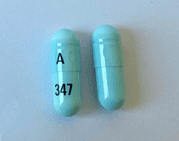Cyclophosphamide Disease Interactions
There are 6 disease interactions with cyclophosphamide.
- Myelosuppression
- Urinary tract obstruction
- Cardiac disease/cardiotoxicity
- Hepatic dysfunction
- Pulmonary impairment
- Renal dysfunction
Cyclophosphamide (applies to cyclophosphamide) myelosuppression
Major Potential Hazard, High plausibility. Applicable conditions: Fever, Bleeding, Bone Marrow Depression/Low Blood Counts, Infection - Bacterial/Fungal/Protozoal/Viral
The use of cyclophosphamide can cause myelosuppression (leukopenia, neutropenia, thrombocytopenia and anemia), bone marrow failure, and severe immunosuppression which may lead to serious and sometimes fatal infections, including sepsis and septic shock. Close monitoring of complete blood counts is essential during cyclophosphamide treatment so that the dose can be adjusted, if needed. Cyclophosphamide should not be administered to patients with neutrophils <1,500/mm3 and platelets < 50,000/mm3. Cyclophosphamide treatment may not be indicated, or should be interrupted, or the dose reduced, in patients who have or who develop a serious infection. Patients should be instructed to immediately report any signs or symptoms suggesting bone marrow suppression such as fever, sore throat, local infection, or bleeding.
Cyclophosphamide (applies to cyclophosphamide) urinary tract obstruction
Major Potential Hazard, Moderate plausibility. Applicable conditions: Urinary Tract Infection, Cystitis
The use of cyclophosphamide is contraindicated in patients with any urinary outflow obstruction. Before treatment initiation, urinary obstruction should be excluded or corrected. Hemorrhagic cystitis, pyelitis, and hematuria have been reported during cyclophosphamide therapy. Adequate hydration and use of a prophylactic agent such as mesna prior to each course of cyclophosphamide therapy reduces bladder irritation and hematuria. Therapy with cyclophosphamide should be administered cautiously in patients with or predisposed to cystitis, including patients with active urinary infections. Treatment should be discontinued if there is sign of urotoxicity as hemorrhagic cystitis, bladder ulceration, necrosis, fibrosis, contractures, etc. Urinary sediment should be checked regularly for presence or erythrocytes and other signs of toxicity.
Cyclophosphamide (applies to cyclophosphamide) cardiac disease/cardiotoxicity
Moderate Potential Hazard, Moderate plausibility. Applicable conditions: Heart Disease
Myocarditis, myopericarditis, pericardial effusion including cardiac tamponade, and congestive heart failure, which may be fatal, have been reported with cyclophosphamide therapy. Supraventricular arrhythmias and ventricular arrhythmias (including severe QT prolongation associated with ventricular tachyarrhythmia) have been reported after treatment with regimens that included cyclophosphamide. The risk of cardiotoxicity may be increased with high doses of cyclophosphamide, in patients with advanced age, and in patients with previous radiation treatment to the cardiac region and/or previous or concomitant treatment with other cardiotoxic agents.
Particular caution is necessary in patients with risk factors for cardiotoxicity and in patients with preexisting cardiac disease. These patients should be closely monitored.
Cyclophosphamide (applies to cyclophosphamide) hepatic dysfunction
Moderate Potential Hazard, Low plausibility. Applicable conditions: Liver Disease
Cyclophosphamide is metabolized by the liver to a biologically active form. Metabolic activation and therapeutic activity may be altered in patients with hepatic impairment. Additionally, Veno-occlusive liver disease (VOD) sometimes with fatal outcome has been reported in patients receiving cyclophosphamide- containing regimens. VOD has also been reported to develop gradually in patients receiving long-term low-dose immunosuppressive doses of cyclophosphamide. Preexisting disturbances of hepatic function seems to also be a risk factor. Therapy with cyclophosphamide should be administered cautiously in patients with compromised hepatic function.
Cyclophosphamide (applies to cyclophosphamide) pulmonary impairment
Moderate Potential Hazard, Moderate plausibility.
Pneumonitis, pulmonary fibrosis, pulmonary veno-occlusive disease and other forms of pulmonary toxicity leading to respiratory failure have been reported during and following treatment with cyclophosphamide. Pneumonitis may develop years after treatment with cyclophosphamide. Patients should be monitored for signs and symptoms of pulmonary toxicity. Caution is advised in patients with preexisting pulmonary impairment.
Cyclophosphamide (applies to cyclophosphamide) renal dysfunction
Moderate Potential Hazard, Low plausibility.
In patients with severe renal impairment, decreased renal excretion may result in increased plasma levels of cyclophosphamide and its metabolites, which may result in increased toxicity. Monitor patients with severe renal impairment (CrCl =10 mL/min to 24 mL/min) for signs and symptoms of toxicity. Therapy with cyclophosphamide should be administered cautiously in patients with a history of or predisposition to renal dysfunction. Clinical monitoring of renal function is recommended.
Switch to professional interaction data
Cyclophosphamide drug interactions
There are 403 drug interactions with cyclophosphamide.
More about cyclophosphamide
- cyclophosphamide consumer information
- Check interactions
- Compare alternatives
- Pricing & coupons
- Reviews (12)
- Drug images
- Side effects
- Dosage information
- During pregnancy
- Drug class: alkylating agents
- Breastfeeding
- En español
Related treatment guides
Drug Interaction Classification
| Highly clinically significant. Avoid combinations; the risk of the interaction outweighs the benefit. | |
| Moderately clinically significant. Usually avoid combinations; use it only under special circumstances. | |
| Minimally clinically significant. Minimize risk; assess risk and consider an alternative drug, take steps to circumvent the interaction risk and/or institute a monitoring plan. | |
| No interaction information available. |
Further information
Always consult your healthcare provider to ensure the information displayed on this page applies to your personal circumstances.


